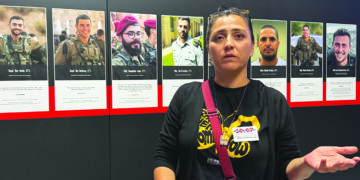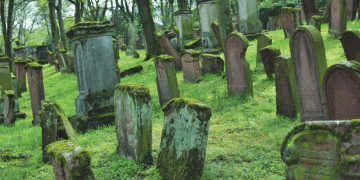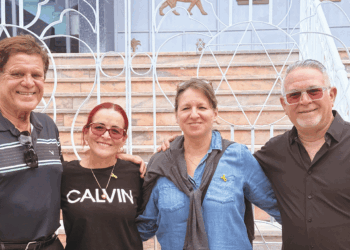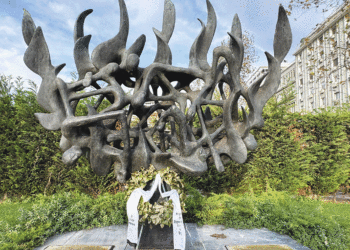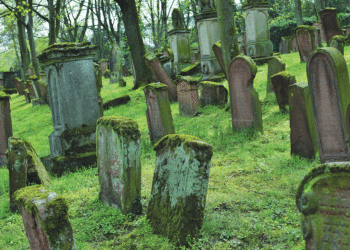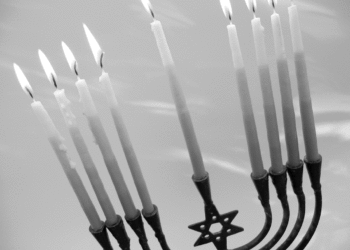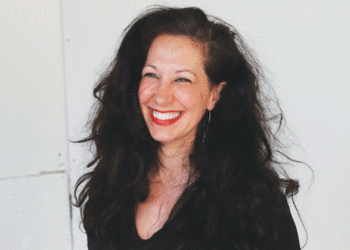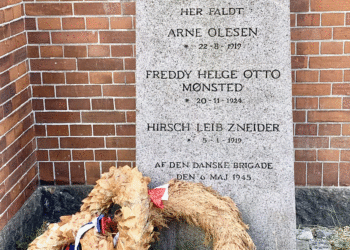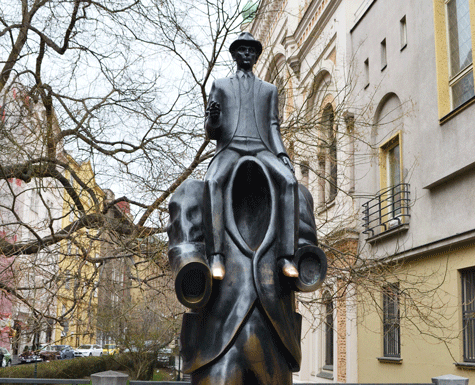
By MORDECAI SPECKTOR
PRAGUE, Czech Republic — On my first full day in Prague, the capital of the Czech Republic, I did some touristy things. I visited the Prague Castle, a landmark looming over the city. The sprawling castle complex includes the towering St. Vitus Cathedral, which appears to be a Gothic edifice but was finally completed in 1929.
A comprehensive admission ticket to the castle complex includes entry to Golden Lane, a picturesque street of tiny houses. The sister of celebrated Jewish author Franz Kafka (1883-1924) lived in house No. 22, and the famous writer penned most of the stories that appeared in the collection titled A Country Doctor in the house, from 1916 to 1917.
After visiting the castle and cathedral, I descended to the Malá Strana district in Prague’s Lesser Town. My objective was the Franz Kafka Museum, which focuses on the life of Kafka and how Prague shaped his outlook. The museum is located in the former Herget Brickworks, a locale that has no relation to Kafka’s life. However, the museum, with its vitrines filled with books, letters, drawings and photos, and videos and other artifacts, does an admirable job of conveying the tortured life of one of the 20th century’s most celebrated writers.
Jewish Museum in Prague
On a Sunday morning, I walked from my tiny garret room in a pension near the famed Charles Bridge to the Intercontinental Hotel in Prague’s historic Jewish quarter. On the plaza in front of the hotel I met the leader of the walking tour, under the auspices of Wittman Tours, the oldest Jewish-owned tourism company in Prague.
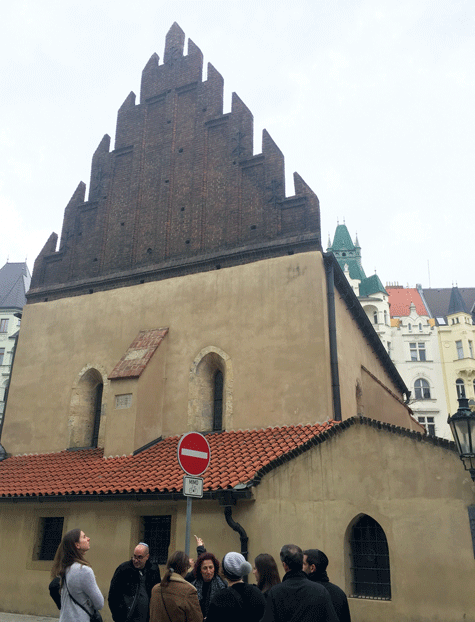
Helena led our group of 10 on a three-hour walking tour of the Jewish Museum in Prague, founded in 1906 and now housed in five separate synagogues and the Old Jewish Cemetery. The original aim of the museum was to gather Jewish artifacts from Prague synagogues, when city’s Jewish town was demolished and redeveloped in the late 19th century.
We first visited the Spanish Synagogue, built in the Moorish style on the site of what was the Old Synagogue, from the 12th century. In one room there’s a collection of silver ritual objects — Torah mantles and crowns, Kiddush cups, candlesticks, etc. — many of which were confiscated from some 150 Jewish communities in Czechoslovakia by the Nazis and destined for display in a planned “Museum of an Extinct Race.”
The pre-World War II Jewish population of Czechoslovakia was around 120,000. Today there are 1,500 Jews officially registered in Prague, out of a Jewish population of 3,000, according to our tour guide. In the entire Czech Republic, perhaps there are 5,000 to 6,000 Jews.
The Spanish Synagogue also contains displays from Terezin, the transit and concentration camp located about 35 miles north of Prague. The Third Reich used Terezin for propaganda purposes; in January 1944, an International Red Cross delegation visited the ghetto/camp, and was treated to a performance by children of the opera Brundibár, by Jewish Czech composer Hans Krása, with a libretto by Adolf Hoffmeister. Also on display is currency used in Terezin; the bills feature an image of Moses holding the tablets of the law.
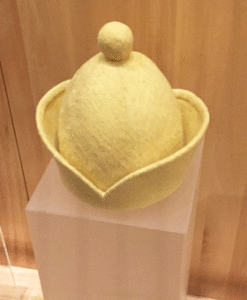
The Jewish Museum in Prague displays local Jewish history in the Maisel Synagogue, which is named after Mordechai Maisel, a wealthy businessman and mayor of the Jewish town in the 16th century, during the relatively liberal rule of Emperor Rudolf II. On display is a replica of the Jewish “badge of shame,” a peaked “Jewish hat,” that male Jews were forced to wear, as per the edict of the Fourth Lateran Council under Pope Innocent III, in 1215. The dress code was meant to prevent inadvertent sexual relations between Christians and Jews and “Saracens” (Muslims).
We shuffled on to the Pinkas Synagogue, which is mainly a Holocaust memorial, with the names of the 77,297 Czechs murdered in the Shoah inscribed on the walls. On an upper level is an exhibit of children’s artwork from Terezin; the most famous drawing is the one by Peter Ginz, a copy of which Israeli astronaut Ilan Ramon carried aboard the ill-fated Space Shuttle Columbia, in 2003.
After the Pinkas Synagogue, we toured the Old Jewish Cemetery (4-20-18 AJW). The first burial in this amazing jumble of headstones was that of Avigdor Kara, a poet and rabbinical judge, in 1439. The cemetery was reduced in size more than 100 years ago, during the razing of the Jewish quarter. There are up to 12 levels of burials in the cemetery, and the last burial took place in 1787. We also toured the building adjacent to the cemetery that houses the community’s Chevra Kadisha, the burial society.
The Klausen Synagogue, the tour’s next stop, was originally three smaller buildings. The shul, which was built by the aforementioned Mordechai Maisel, features an exhibit of hanukiot, Hanuka menoras. An adjacent gift shop has your chotchkes and finer Judaica items.
The final stop on our walking tour was the Old-New Synagogue, which dates to the late 13th century. The shul is bound up in the legend of the Golem, the monster created out of mud from the banks of the Vltava River by Rabbi Yehuda Loew ben Bezalel (1525-1609) to protect the Jews in the ghetto from anti-Semitic pogroms. At some point, the Golem of Prague ran amuck, and Rabbi Loew had to immobilize it by removing the letter “shem” from its mouth. The Golem was then stored it in the synagogue’s attic geniza (repository for Torahs and Jewish prayer books). Rabbi Loew’s grave can be seen in the Old Jewish Cemetery. We were told that the oldest continually functioning synagogue in Europe does not have a mechitza (divider) or a balcony for women. Rather, female congregants had to gather outside of the synagogue walls. And the street between the Old-New and Klausen synagogues is lined with booths geared to the tourist trade — plenty of Golem-related souvenirs on offer.
A memorial underfoot
I knew about the stolperstein (stumbling stone) project to memorialize Jewish victims of the Holocaust. I had seen the 2008 documentary Stolperstein, by Dörte Franke, which focuses on German artist Gunter Demnig, who, in the 1990s, came up with the idea of marking the homes of Jewish victims by replacing a sidewalk paving block with a bronze marker, with the name of the person who had lived in the home before being taking away by the Gestapo or their henchmen in various countries.
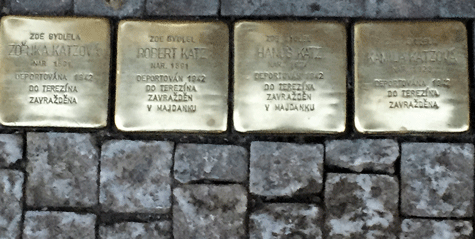
One night in Prague I came upon some stolpersteine in the Jewish Town. The names on the bronze markers are Zdenka Katzova, Robert Katz, Hanus Katz and Kamila Katzova, who were deported to Terezin — and then murdered in the Majdanek death camp, according to inscription on two of the stolpersteine.
There are more than 61,000 stolpersteine throughout Europe — the largest Holocaust memorial on the continent. Some markers memorialize Roma victims of the Nazis.
A Jewish official
At the recommendation of European Jewish culture maven Ruth Ellen Gruber, I met with David Kraus, who runs kosher European tours for a company called Travellent. We met at a chic Italian bistro called Aromi, on Náměstí Míru (Peace Square), which is anchored by the Church of St. Ludmila, a neo-Gothic Catholic church built in the late 19th century. (The Náměstí Míru metro station is the deepest in the Prague system, and is reached by an escalator that stretches for 87 meters, nearly the length of a football field.)
Kraus, 32, was wearing a yarmulke under his baseball cap, and he said it’s not a problem in Prague. Indeed, when he was hanging out in bars some years ago, he found that this visible symbol of Jewish identity was an icebreaker. People wanted to talk to him, and at some point in conversations, he would hear something like, “I think I’m Jewish, too.”
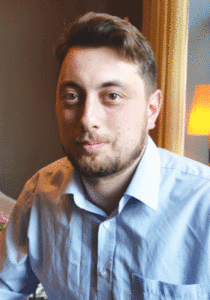
For someone relatively young, Kraus displayed a remarkable grasp of Jewish and European history, and even recalled the tumultuous events of Czechoslovakia’s Velvet Revolution, when the people shook off their Communist overlords — although he was only five-years old at the time. He recalled attending a mass demonstration and being confronted by a riot cop wearing a helmet and visor, who demanded to know what he was doing on the street.
“I’m demonstrating,” the brave boy responded.
Kraus’ father, Tomas Kraus, executive director of the Federation of Jewish Communities in the Czech Republic, had a slightly different recollection of his son’s brush with the law. During a conversation the following day, the elder Kraus, 64, said that his son had gotten lost for a time in the crowd. The demonstration had been moved from Wenceslas Square, which stretches for several blocks in Prague, to a large field in order to accommodate a demonstration of some 300,000 Czechs.
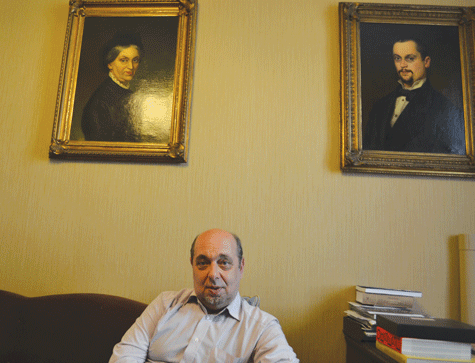
Tomas Kraus has been in his post since 1991. Before that he worked in “show business,” with a record company and an agency for creative artists. During the Communist years, he operated in what he called the “gray zone,” organizing jazz festivals that were not explicitly sanctioned by the government. Some friends and colleagues were arrested and imprisoned during the 1980s, as the dissident movement gained momentum in Czechoslovakia. This is the milieu out of which came Václav Havel, the dissident playwright who would become the president of Czechoslovakia after the Communist era ended.
The Federation work Kraus directs involves the management of properties repatriated to the Jewish community about 20 years ago. The popular Jewish Museum in Prague also provides an income stream for the Jewish community, which oversees a large social services network. Kraus’ office is in the historical Jewish town hall, in which Franz Kafka once lectured on Yiddish literature.
We also discussed the rise of nationalism in Europe, particularly the situation in Hungary and Slovakia, where neo-Nazi parties have gained large followings. “History is repeating itself,” Kraus commented.
The Czech Republic, which was the only democratic country in Central Europe prior to World War II, is “still a safe haven” for Jews, according to Kraus.
(American Jewish World, 5.4.18)



